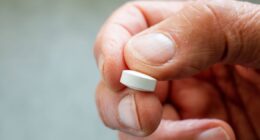Giving a man a one-off jab of his own blood could be a new treatment for erectile dysfunction.
In a recent study, researchers gave the injection to men undergoing shockwave therapy – already used to help those with erectile dysfunction (ED) – and found it significantly increased its effectiveness.
Six weeks after having the combination treatment, the men, some of whom had had ED for up to 19 years, reported that their sexual performance scores almost doubled on average, compared with just 25 per cent for those having only the shockwave therapy.
ED is usually the result of blood vessels supplying the penis becoming narrowed, so there’s insufficient blood flow to achieve an erection. This can occur as a result of cardiovascular disease or diabetes, for example.

The theory is that the growth factors stimulate the growth of new blood vessels, repair penile muscle cells and lower inflammation (a contributing factor to erectile dysfunction)

PRP injections are gaining popularity for conditions ranging from sports injuries to hair loss
The first-line treatment is with drugs such as sildenafil (brand name Viagra), which improve blood flow to the penis.
But around a third of men find these drugs don’t help. They are also not suitable for men who take heart medication that dilates blood vessels (as blood pressure could drop too low, for instance).
Shockwave therapy – where painless shockwaves are fired into the penis – is thought to help repair damaged tissue and blood vessels: it isn’t offered on the NHS but is available at private clinics.
A review in The American Journal of Men’s Health in 2022 found the treatment worked best for moderate cases.
In the new trial, 160 men were either given two sessions of shockwave therapy weekly for six weeks, or shockwave therapy plus an injection of their own blood.
A sample of their blood was spun in a machine to produce platelet-rich plasma (PRP), which has a high concentration of growth factors. This was then injected into the base of the penis at the start of the six-week trial.
PRP injections are gaining popularity for a variety of conditions, from sports injuries to hair loss.
The theory in this case is that the growth factors stimulate the growth of new blood vessels, repair penile muscle cells and lower inflammation (a contributing factor to ED).
As well as an improvement in symptoms, the men who had the combined treatment had measurably improved penile blood flow, compared to those who had shockwave alone, reported urologists from RUDN University in Moscow, writing in the journal European Urology Supplements earlier this year.
Testosterone levels also rose slightly in the combined group.
Previous research has found PRP may have an effect on hormone production, too.
Professor Raj Persad, a consultant urologist at Bristol Urology Associates, described the new approach as ‘innovative’ adding: ‘Testosterone drives male libido whilst blood flow and nerve regulation are important for the ‘mechanics’ of erectile function. It will be interesting to see the long-term effects of this approach.’










